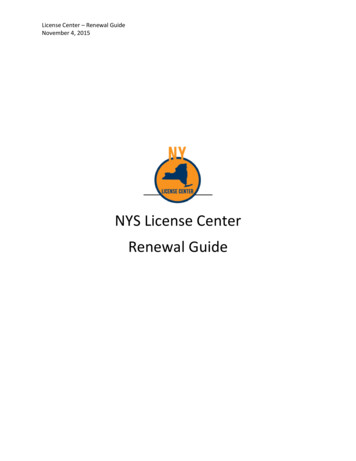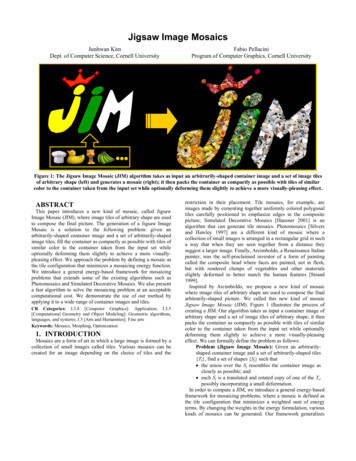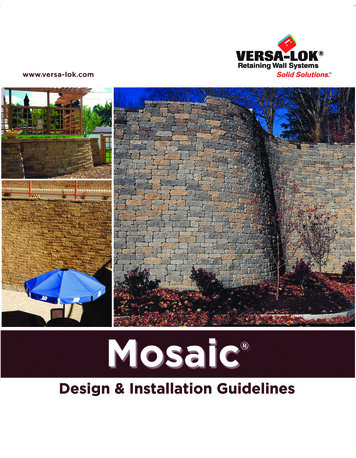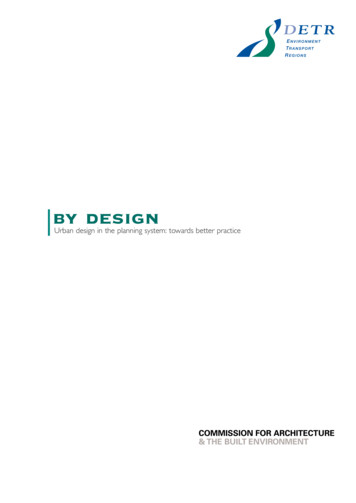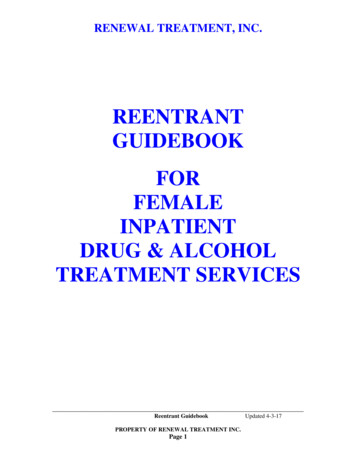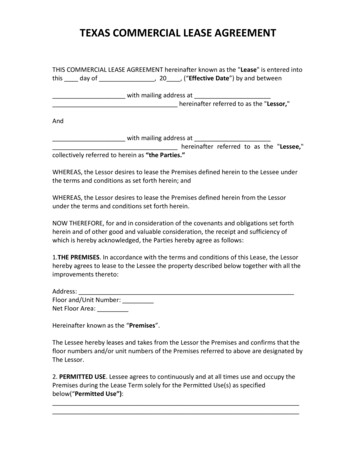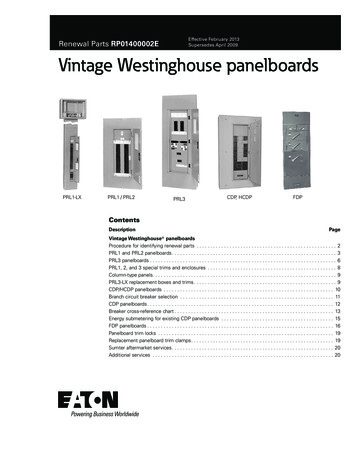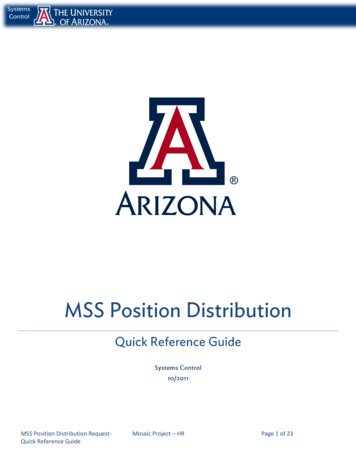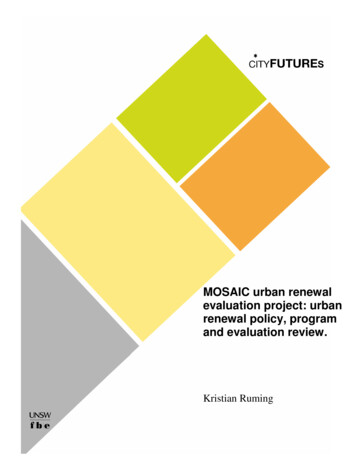
Transcription
MOSAIC urban renewalevaluation project: urbanrenewal policy, programand evaluation review.Kristian Ruming
MOSAIC urban renewal evaluation project: urban renewalpolicy, program and evaluation reviewKristian Ruming City Futures Research CentreResearch Paper No.4May 2006ISBN 1 74044 037 4.City Future Research CentreFaculty of the Built EnvironmentUniversity of New South WalesKensington, NSW 20522
City Futures Research Centre, University of New South WalesNational Library of AustraliaCataloguing-in-Publication data:Ruming, Kristian James.MOSAIC urban renewal evaluation project: urban renewal policy, program andevaluation review.Bibliography.ISBN 1 74044 037 4.1. Urban renewal - Australia 2. Urban renewal – Research - Australia. I. University ofNew South Wales. City Futures Research Centre. II. Title.307.34163
CITY FUTURES RESEARCH CENTRECity Futures is a University Research Centre dedicated to developing a betterunderstanding of our cities, their people, the policies that manage their growth the issuesthey face, and the impacts they make on our environment and economy.Based in the Faculty of the Built Environment, City Futures is interdisciplinary in outlookand activity. It draws on the skills and knowledge of those within the Faculty whoseknowledge encompasses the physical and spatial aspects of urban living, as well as thosein other Faculties in the University whose interests coincide with our focus on the city.The core activity for City Futures is research. It offers a place where scholars can pursueresearch on aspects of urban development and change. But it also focuses outwards,engaging with the wider audience beyond the University. Wherever possible, CityFutures works in partnership with the community, government and business to contributeto growing the evidence base on the issues that impact on urban regions and how we canbetter manage their dynamic progress.City Futures will also strongly focus on the training of the next generation of urbanresearch scholars through an active postgraduate research program. We are committed toexpanding the skills and capacity of young urban researchers and to communicating thevalue of good research to those involved in making policies that impact on the city.Together with colleagues in other institutions who share our focus and passion, CityFutures is committed to research and training that will contribute to better urbanoutcomes for Australia and beyond.THE AUTHORKristian Ruming is a Research Officer at the City Futures Research Centre, Faculty of theBuilt Environment, University of NSW, Sydney 2052, Australia. Email:kristianr@fbe.unsw.edu.au.4
1. INTRODUCTION . 6PART ONE: OVERVIEW OF URBAN RENEWAL . 82. EVALUATION, URBAN RENEWAL AND SOCIAL MIX . 82.1 Social Mix . 123. INDICATORS . 22PART TWO: URBAN RENEWAL AND EVALUATION IN AUSTRALIA . 274. NEW SOUTH WALES . 284.1 The Neighbourhood Improvements Project and its Evaluation . 284.2 Other Early DoH Evaluation/Appraisal . 354.2.1 Cost Benefit Analysis in New South Wales . 374.4 DoH Current Evaluation: Housing Healthy Communities . 434.5 Recent Approaches to Evaluation in New South Wales . 455. SOUTH AUSTRALIA. 495.1 Early Descriptive Evaluation . 505.2 Salisbury North Urban Improvement Project (SNUIP) . 515.3 Current Renewal Evaluation Framework. 595.3.1 Realist Approach. 615.3.2 Meta-Evaluation. 656. QUEENSLAND. 677. VICTORIA . 768. WESTERN AUSTRALIA . 79PART THREE: INTERNATIONAL EXPERIENCES OF RENEWAL ANDEVALUATION. 819. THE US EXPERIENCE – HOPE VI. 8110. THE UK EXPERIENCE. 8510.1 The 3R’s Guidance . 9711. THE EUROPEAN EXPERIENCE – IMPACT L . 10311.1 Relevance . 10511.2 Internal Coherence . 10611.3 External Coherence. 10711.4 Effectiveness . 10811.5 Performance . 10911.6 Ethicality . 11011.7 Profitability . 11111.8 Legitimacy . 11211.9 Reproducibility . 11312. CONCLUSION . 117REFERENCES . 1185
1. IntroductionThis research paper represents the first stage of a research project into the longitudinal evaluationof urban renewal interventions initiated by the NSW Department of Housing on its estates. Thefirst stage of the project is to develop a theoretical and methodological framework for themonitoring and evaluation of these estates over a ten-year period. This research is funded by anARC Linkage research grant with the NSW Department of Housing beginning January 2005.1This research paper provides a thorough review of the historical and current best practice in termsof monitoring and evaluating urban/community renewal/regeneration. Drawing on literature andframeworks from across Australia, as well as drawing on the leading international approaches, theresearch paper provides the foundation on which the NSW Department of Housing’sMeasurement of Social and Asset Investments in Communities (MOSAIC) framework is built. Intotal 85 journal articles, policy documents and research reports are reviewed here.The research paper starts with brief discussion of history and characteristics of social housingestates in the Australian context. Following the wealth of literature/research on these estates, it issuggested that they are characterised by local concentrations of social disadvantage, welfarismand powerlessness, stigma, poor access to services and facilities, isolation, transience, crime andvandalism, and fear and poor public safety. It is in this environment which policy is increasinglyengaging in the processes of urban renewal or community regeneration, often implicitly throughthe process of altering the areas’ social/tenure mix, in efforts to improve the social, economic andphysical environment of these areas. Further, given the increasingly stringent fiscal environmentin which social housing departments operate in the Australian (and indeed, international) context,the evaluation and measurement of the impacts of such interventions is becoming increasinglyimportant. Thus, this section also discusses some of the indicators increasingly used in evaluatingthe (financial/economic) success of these programs. As such, Rogers and Slowinski (2004)suggest that any evaluation should:-Have multiple dimensions as the focus for the evaluation;-Set realistic evaluation goals with regards to the capacity of the evaluation to answerquestions of outcome, impact, cause and effect;1Identify underpinning assumptions;Project ID: LP0668205 – Assessing the Effectiveness of Public Housing Estate Regeneration in NSW.6
-Undertake systematic and comprehensive data collection using both qualitative andquantitative approaches;-Have a central concern with learning, development, and understanding change, ratherthan compliance and accountability;-Adopt a conceptual approach which supports investigation of mechanisms, process andcontext as well as impact, outcome and cost; and,-Give a central role to the community.Part Two discusses urban renewal and evaluation in Australia. Starting with discussions of NewSouth Wales and South Australia (arguably the states with the longest history of renewal,regeneration and evaluation), followed by Queensland, Victoria and Western Australia, thissection explores the historical approaches, research and outcomes of interventions into publichousing communities. Special attention is paid to the methodologies and approaches to evaluatingthe success of each of these projects. Importantly, the approaches advocated by each state areconspicuous in their difference to each other. While providing a historical picture of the policyframeworks in each state, the purpose of this section is to illustrate the current state of play in theAustralian context. By exploring the current approaches to evaluation in other states, theframework developed as part of the MOSAIC project seeks to build upon the strengths of theseapproaches and adapt them to the institutional and social environment of NSW estate renewalinterventions. Nevertheless, the theoretical foundations of these approaches are vast ranging fromearly cost-benefit approaches in NSW, realist and meta-evaluation approaches in South Australia,a logical model in Queensland, a pragmatic approach in Victoria, and descriptive analyses inWestern Australia. Each of these approaches is reviewed in light of their potential inclusion in theNSW MOSAIC approach. Of those current state approaches currently being developed orimplemented, the Victorian model is positioned as the most relevant to NSW under a hierarchicalevaluation model.Part Three of this research paper explores some of the major approaches implementedinternationally in the evaluation of social housing interventions. This section starts with adiscussion of the United States and programs undertaken as part of HOPE VI. It is suggested that,given the idiosyncrasies of American public housing and the implementation and evaluation ofrenewal interventions, that the US approach adds little to understanding renewal interventions inNSW. In contrast, this section positions European policy frameworks (both the UK and EU) asthe cutting edge of evaluation approaches and central to developing a theoretical and practical7
evaluation framework for NSW. After providing a brief history of urban/community renewalinitiatives undertaken in the UK, this section then discusses the 3R’s (regeneration, renewal andregional development) Guidance implemented in 2004. 3R’s is positioned as the current state of‘best-practice’ in evaluating place-based policy interventions. With is five-stage appraisal andevaluation cycle the 3R’s approach is positioned as a practical means (process) through whichinterventions of the NSW Department of Housing can be measured and evaluated. Followingdiscussions of the UK model, this section concludes with a review of the IMPACT modelespoused by the EU. Drawing from the theoretical concerns of ‘social exclusion’, the IMPACTtool is designed to provide assessments of social impacts in spatially and temporally definedprograms. While theoretically driven by nine central components, the IMPACT models offers anessentially policy based approach to urban interventions, exploring the success of process andprogram operation, as well as outcomes at the site of the intervention. In this sense, the IMPACTapproach is seen to offer a unique opportunity to evaluate the processes of urban renewal inNSW, as well as the outcomes.In conclusion a multi-scaled monitoring and evaluation framework is identified as the most suitedto measuring the complex interactions and outcomes of urban renewal interventions as initiatedby the NSW Department of Housing. The suggested framework draws on and combines elementsthe pragmatic approach of the Victorian Department of Human Services (2002) NeighbourhoodRenewal: Evaluation Framework, 2002-2003, the process initiatives of the UK 3Rs Guidancewhich fosters the collection of data amenable to the development of a comprehensive cost-benefittool, and the theoretical and conceptual approach of the European Unions’ IMPACT evaluationtool. The combination of these tools into a coherent framework will be presented is subsequentpublications.Part One: Overview of Urban Renewal2. Evaluation, Urban Renewal and Social MixParry and Strommen (2001) identify that in the Australian context, State Housing Authorities(SHA’s) increasingly allocated funds to regeneration projects in the 1990s, as they attempted toovercome the high level of disadvantage which characterised, particularly Radburn, estates. Theemergence of renewal projects has come to represent one of the most prominent developments in8
social housing policy over the past decade (Randolph and Judd, 2006). From the early 1980s topresent, hundreds of millions of dollars of public and private funds have been spent onregenerating disadvantaged Australian public housing neighbourhoods (Hughes, 2004).Contemporary Australian urban regeneration policies, aimed at disadvantaged public housingneighborhoods, are generally concerned with the issue of balancing social mix to create moresocio economically diverse communities. These urban renewal programs have undertaken a broadmix of renewal activity, ranging from outright physical redevelopment and stock replacement forsale, to community development type initiatives to improve social and employment outcomes forresidents (Randolph and Judd, 2006). The major strategy to achieve a more balanced social mix isthrough diversifying housing tenure, to lower concentrations of public housing and increaseowner-occupied housing on estates (Arthurson, 2004). Since the early 1990s there has been a shiftby SHAs away from new construction to renewal through upgrading, demolition and building ofnew housing via joint ventures (Arthurson, 1998). As part of this trend, tenure mix is positionedas a strategy, which can break up the concentration of disadvantage on estates. It is suggested thatsuch strategies are furthered by large state government debt, cuts to funding under the CSHA, andincreased privatisation. Randolph (2000) suggests this interest in renewal stems from a growingrealisation that something had to be done with public housing estates that were suffering form thecombined impact of declining investment, falling asset values, increasing concentrations ofpeople with social disadvantages, and rising management costs.Randolph and Judd (2006) suggests that the fundamental problems facing SHA’s in Australia aredue to an increasingly stringent environment of fiscal restraint and policies that have moveddecisively against direct provision of lower income households. It is suggested that as a result ofthe recent shift in the subsidy system from public housing to rent assistance, the social base ofpublic housing has narrowed to the point where the sector now has an explicit welfare role and formost tenants has become a tenure of ‘last resort’ (Randolph and Wood, 2003). As a result, it isidentified that fringe estates are often characterised by a spatial mismatch due to theirgeographically distinct location from job rich areas, spatial mismatch between workers and jobopportunities, and location discrimination arising from neighbourhood stigmatisation oftenhaving an adverse effect on employment outcomes (Hughes, 2004). In this context it is suggestedthat redevelopment is seen by many SHA as a solution to the multiple problems confrontingestate developments, such as: the physical limitations of the existing stock, funding constraintsand the concentration of socio-economically disadvantaged tenants on estates (Bowey, 1997).9
Further, Arthurson (2004) suggests that the negative effects of residing in these types of lowincome mono-tenure neighbourhoods include:-Lack of access to social networks, which link residents to job opportunities;-Limited role models to integrate residents into the appropriate behaviours of widersociety. This factor is linked to problems of crime, low education retention rates, poorhealth and high unemployment;-Postcode prejudice and stigma associated with residing in areas that are perceived asnegative and undesirable places; and,-Decreased access to a range of health, education and community services due to serviceoverload within particular areas.The year 2000 saw a number of publications centred on urban renewal and regeneration in NSW.The importance of urban regeneration as the central notion of pubic housing management inAustralia is exemplified by the convening of the Creative Approaches to Urban Renewal: AConference on the Redevelopment of Public Housing in Perth. As part of this conference twopapers discussed changing policy initiatives in Sydney’s western suburbs. As part of thisconference Randolph (2000) highlights the increasingly important role the notions of socialcapital and exclusion play in renewal projects. However, in critiquing the literature that hasemerged in Australia over the disadvantaged nature of public housing estates and the potentiallack social capital, Randolph suggests one of the main criticism of social capital approaches isthat they tend to ignore the importance of “place” and locality in the definition of whatcommunities are. In contrast, the advantage of social exclusion/inclusion as a framework forpolicy action is that it focuses on the interconnectedness of the problems – and this clearly meansthat policy responses need to be equally interconnected – to create “joined up” policies for“joined up” problems in the jargon as well as the place based nature of these problems (Randolph,2000).At the same conference Woodward (2000) – the then NSW Department of Housing RegionalDirector of the South Western Sydney Region – positioned community renewal as the quietrevolution gathering speed through many towns and cities in New South Wales. This renewalprocess as envisaged by the Department allows the carefully planned separation of land uses andparticularly the segregation of public housing tenants into discreet homogeneous communitiesthat is being replaced by multi-purpose land use zoning and pro-active policies of integration.Under this framework of community renewal it is suggested the estates are being redesigned,10
refurbished and broken up to mix tenure. Poor quality housing is demolished, refurbished or sold.Residents are becoming empowered to be part of the decision making process. Partnerships arebeing forged with the private sector and support agencies (Woodward, 2000). While communityrenewal is positioned as the central tenet of current Department management strategies, noevaluation process to measure (qualitatively or quantitatively) the outcomes of these processes issuggested, rather Woodward (2000) refers to the previous work undertaken by Stubbs (1998) asjustification for continued renewal projects.In addition Hassell (1997) in their discussion of the New South Wales NeighbourhoodImprovement Program (NIP) suggest that the social issues associated with public housing estatesinclude the local concentration of social disadvantage, welfarism and powerlessness, stigma,isolation, poor access to services and facilities, fear, crime, vandalism, depression, alcohol anddrug dependency, transience, poverty and unemployment. In addition, the lack of social mix inneighbourhood’s means there is little opportunity for intergenerational support. In a similar vein,Hall (1997) suggests that (British) estates, which are subject to renewal projects, are characterisedby a mix physical and social problems (table 1). It is this blend of social and physicaldisadvantage, which increasingly seem to be overcome by policies, which alter an areas socialmix.Table 1: Physical and Social problems which characterise house estates (Hall, 1997)Physical Issues- Structural faults and poor housing stock, especially poor insulation and heating;- An impersonal and alienating physical environment;- Some peripheral housing estates have experienced the problems of vandalism and decay associatedwith high levels of housing voids;- Lack of variety in housing types and sizes;- Physical isolation, including external physical barriers such as major roads and railway lines; and,- The distance between estates and other parts of the city.Social Issues- Concentrations of marginalised people, such as the disabled, single-parent households and householdscontaining no employed adults;- Health problems;- A high level of benefit dependency;- Crime, including drug abuse and vandalism;- A young population, with many youth’ problems such as poor educational achievement, and lack ofrecreational opportunities;- Residents of some estates have been characterized as insular in their world-view, and apathetic;- A high rate of population turnover frustrates community cohesion; and,- Many peripheral estates suffer from social stigmatisation by outsiders, particularly from employers.11
2.1 Social MixAlong with numerous other countries, Australia is currently exploring solutions to the problemsof large public housing estates, built mainly in the period following the Second World War toaddress the then shortage of housing (Arthurson, 1998; Randolph and Wood, 2004). The physicalproblems of ageing and poorly designed housing reflect only part of the difficulties as estateresidents are increasingly characterised by poverty, low education levels and high unemployment(Arthurson, 2002). Further, in light of recent debates and issues concerning the disadvantagenature of public housing estates Stubbs et al (2005) suggest that social mix, as presented bySHAs, is often positioned as the panacea for social and economic problems. The principlestrategy of social mix is the proposed break up of large estates through sale of land for privatesector redevelopment while retaining or buying back some land or housing for public housing. Inthe US the introduction of social mix through the redevelopment of public housing, has primarilybeen achieved through the Federal HOPE VI program, began in 1993. Under the HOPE VIprogram, severely disadvantaged public housing estates are in part or totally demolished andrenewed using planning and implementation grants. In a similar vein Randolph and Wood (2003)suggests that demolition is an increasingly common approach in the Australian context to reducephysical concentrations of stock with renewal at lower densities. In the UK context there has beena recent resurgence of interest in creating mixed income communities on social housing estatesthrough the UK regeneration policy as part of the Blair Labour Government’s focus on tacklingsocial exclusion (Arthurson, 2002).Social mix signifies not only an approach to urban renewal, but also set of widely accepted urbanorthodoxies. It is suggested that through tenure diversification (which leads to social mix) a‘balanced’ and therefore more stable community can be achieved (Ruming et al, 2004). Theobjective of social mix is therefore to normalise estates, de-stigmatise their populations, andprovide the benefits that are seen to accrue from living in conventional residential areas. Thebenefits of social mix which are said to flow from tenure diversification include:-Promotion of greater social interaction and social cohesion;-Better community “balance”;-Encouragement of mainstream norms and values;-Creation of social capital;-Overcoming place-based stigma;-Improved non-shelter outcomes:oOpening up of job opportunities;12
-oAttracting additional services to the neighbourhood;oReduced crime and anti-social behaviour;oImproved educational opportunities;Leading to sustainability of renewal/regeneration initiatives (Randolph and Wood, 2004)While ‘social mix’ is increasingly positioned at the centre of public housing renewal strategiesmore recent reviews of social integration call into question the uncritical acceptance of the ‘socialmix’ orthodoxy (Stubbs at al, 2005). Internationally, very little research exists to test thesuggestion that altering an areas social mix has positive impacts for public tenants (Ruming et al,2004). However, within the literature three interrelated and common themes arise. The first themeconcerns the difficulties of fostering the requisite social contact between public tenants andhomeowners in order to actualise the anticipated benefits of integration. Second, some researchersquestion whether placing residents with different income levels in the same neighbourhoodcreates tensions rather than social cohesion through raising awareness of class differences(Ruming et al, 2004). The third questions the assumption that the presence of middle-incomehomeowners facilitates the provision of additional services to the regeneration area (Arthurson,2002). According to Randolph and Wood (2004) this implies that social mix has to be seen morein terms of the positive benefits it may generate for housing management problems on largerestates, rather than on concerns about ‘balanced communities’ per se. Further, Arthurson (2002)suggests four major impacts arising from varying social mix on the estates: first, the supply ofpublic housing stock ultimately decreases; second, the effects on existing estate communities astenants are relocated; third, questions about moving disadvantaged tenants around rather thanaddressing the sources of problems; and finally, the identification of what aspects communityregeneration is targeted to assist. In conclusion Arthurson (2002) suggests that within Australianestate regeneration policy, there are major expectations that social mix strategies will assist increating inclusive, cohesive and sustainable communities. However, the integrity of claims madefor social mix remains inconclusive and it is questionable whether the social benefits the policiespurport to generate or the envisaged communities will eventuate. Put simply, urban renewalprograms address some of the physical symptoms of disadvantage but not the underlying causes –the social and economic marginalisation of the populations on these estates. In other words, thesekinds of ‘renewal schemes improve the place but at the expense of the community’ (Randolph,2000, p11, original emphasis).13
Thus, in an effort to apply the broad (policy) objectives of social mix, by the mid-1990s mostAustralian states had implemented estate renewal programs (Randolph and Wood, 2003). Most ofthese were primarily concerned with physical aspects of the estates and the underlying problem ofthe falling asset values. These programs tended to be positioned as initiatives capable ofimproving the social aspects of estates by marketing and sales policies thereby engineering socialchanges through a greater mix of tenures and therefore household types. However, there has alsobeen a growing recognition that there was more to renewal than just physically upgrading theproperty and selling it off as the introduction of initiatives aimed at improving social andemployment aspects of estate communities become increasingly prominent (Randolph, 2000).Thus, Arthurson (1998) suggests renewal is increasingly positioned as an approach which canconfront the two major causes of social disadvantage: social class segregation and the differentialequity of access to services in the redevelopment area as compared to others. Nevertheless,despite the increasing funding allocated to regeneration/renewal projects, Parry and Strommen(2001) identify the limited level of evaluation and lack of a common approach, making crossanalysis, both between estates and States, difficult.In her review of literature on urban renewal projects, Bowey (1997) highlights seven majorthemes:1) A concern with localised areas of acute disadvantage often characterised byconcentrations of single housing tenure and limited social mix, a lack of access to basicamenities, community facilities and employment opportunities and poor housing andresidential environments;2) Areas may be subject to a “cycle of decline” where people who are better off socially andeconomically move form the area as problems exacerbate and people with lesserresources m
Cataloguing-in-Publication data: Ruming, Kristian James. MOSAIC urban renewal evaluation project: urban renewal policy, program and evaluation review. Bibliography. ISBN 1 74044 037 4. 1. Urban renewal - Australia 2. Urban renewal - Research - Australia. I. University of New South Wales. City Futures Research Centre. II. Title. 307.3416


